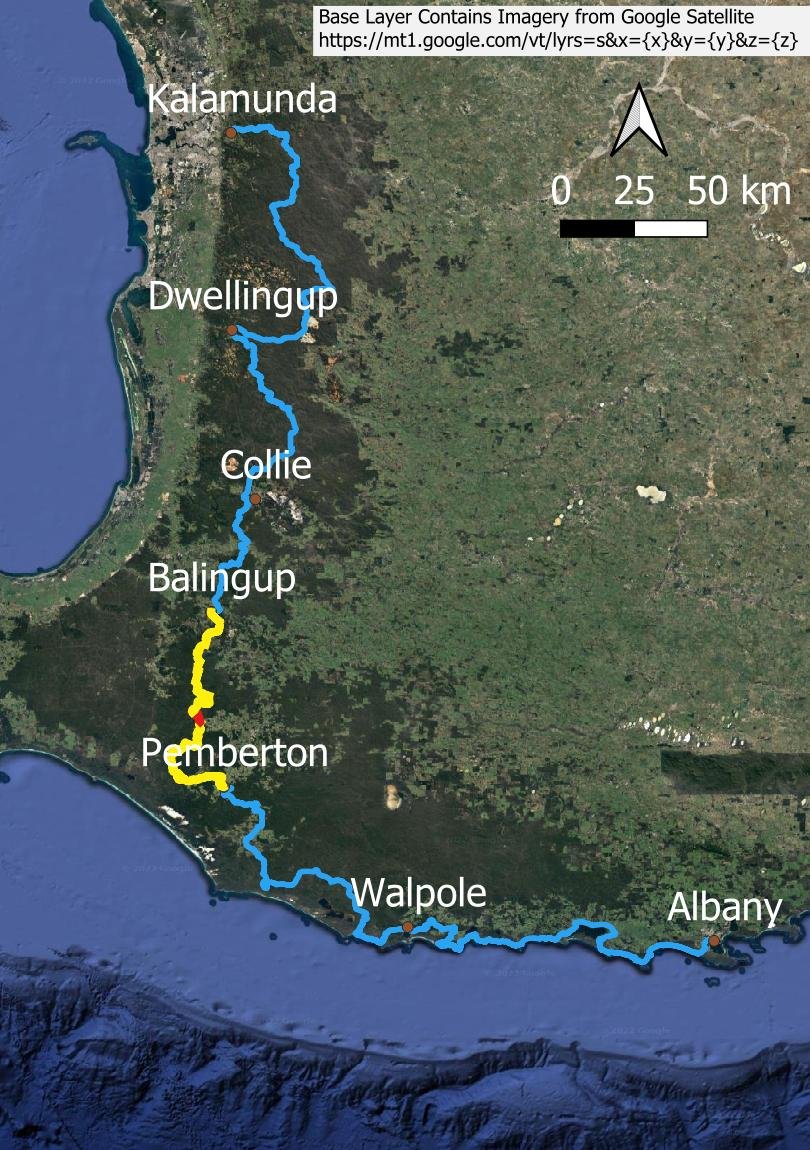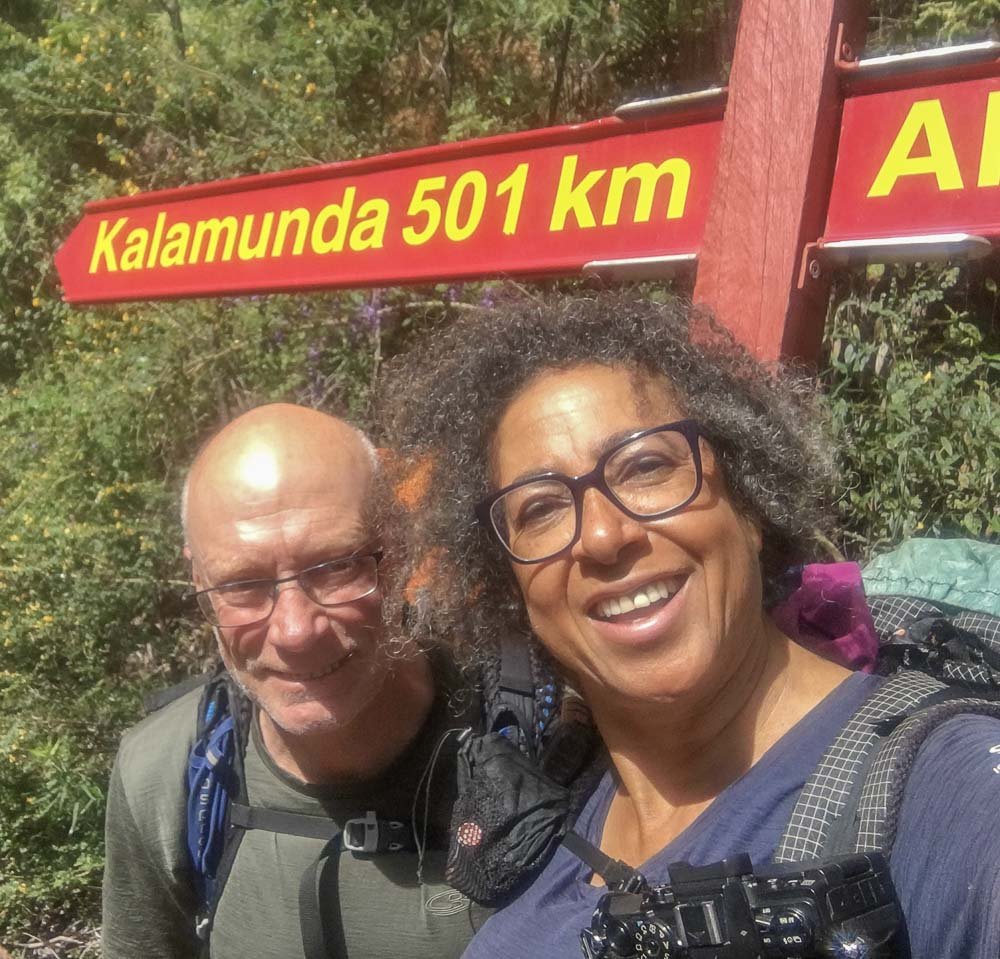Days 37 and 38: Tom Road to Boarding House
We acknowledge the Nyoongar People as the traditional custodians of the land and waters along the Bibbulmun Track
Beautiful river scenes at Greens Island
Tom Road to Boarding House would have been long if done in one day, but this is the second section we had decided to split when rejigging our itinerary in Balingup. Greens Island is around halfway between Tom Road and Boarding House, so a perfect location. It’s a drive-in campground with a toilet, but only one campervan is there when we stay. This makes for two comfortable days and now my body is noticeably healing: fantastic because it means small tweaks as needed will ensure we can complete the hike.
An alternative is accommodation near One Tree Bridge at Graphite Road. There are at least three places in close proximity: One Tree Bridge Chalets, Karri Glade Chalets, and Blue Moon Forest Lodge. Our friends Patrick and Helen did this and treated themselves themselves to a little luxury. You most likely will need to book in advance and check for any minimum two or more night stay requirements. Or you could get a prearranged taxi into Manjimup (which is about 15 minutes drive away - there is no phone reception at One Tree Bridge).
Overview map. Use the Bibbulmun Track Foundation Map 5: Pemberton
Tom Road to Greens Island is 14.7 km with 270 m elevation gain and Greens Island to Boarding House 10.4 km and only 225 m elevation gain
After a truly astonishing dawn chorus - twitchers will love this section! - we set off. A few short steep ups and downs with - oh, joy! - steps!
Some of the Bibbulmun follows old bullock logging tracks. I love them because the gradient is so gentle. Sometimes you’ll see these enormous logs beside the track, with a small dirt ramp beyond, which were used to load timber onto the drays.
Caladenia flava ssp sylvestris in bud, growing on a log
Caladenia latifolia
With one of the wettest Junes on record and huge storms before we walked, a lot of deadfall litters the track. Although volunteers are cleaning up it is a massive job and, rather than complaining in the hut logbooks, we hikers should be grateful that it’s being done at all. Just let them know where the issues are, and it will be taken care of: thank you so much, trail vollies! The vast majority of us hikers are hugely appreciative of everything you do: ignore the self-entitled whingers.
Pimelia sp. with a native fly.
More flat bullock track. Yay!
Some hikers also complain about this section: it’s the 200 km “tunnel of green.” Actually, it’s not. If you take your time there is an enormous amount to see, like this lovely pink form of Hardenbergia comptoniana, and the towering trees overhead are exhilarating.
Here we are at Greens Island campground amongst the casuarinas. It’s been raining on and off - mostly on - so we set up the tent in the rain and then warm up inside. Single skin hybrid tents like the Zpacks Triplex, Tarptent Double Rainbow and Durston XMid Pro, and double-skin ones like the Durston XMid 2P and Tarptent Stratospire Li that can be set up fly-first or all-in-one, are vastly better on rainy hikes than ones where you must set up the inside first, then throw over the fly. If there is no break in the weather, the inners of these tents will be drenched by the time you get the fly on.
All our backpacking tents can be set up in bucketing rain without getting the inner wet. It is a HUGE advantage and, if you are choosing a tent for a thru-hike where you will be spending consecutive days in a tent and you expect to experience significant rain, we recommend that you ensure that it is single skin or can be set up fly-first or all-in-one. There are many budget options that do this too, like the Lanshan.
Enjoying dinner in the tent. We try to avoid cooking in the vestibule and don’t recommend anyone cook in them, but sometimes it’s necessary.
Not tonight, though, because there is a tiny shelter in the form of a registration station that provides cover. You could set up your tent under the verandah if you had a mind to, and cook in the little alcove.
Here’s Geoff cooking breakfast the next morning.
Poha! We’ve since tweaked it to include more protein in the form of dried edamame and extra nuts.
Today we’re following the Donnelly River the entire way to Boarding House.
Common dampiera (Dampiera linearis) with Chorizema in the background.
Fan flower (Scaevola sp) and Chorizema
So this is the much-maligned “tunnel of green”, with coral pea (Kennedia coccinea) and white clematis draped in fabulous abandon.
Glimpses of One Tree Bridge Chalet accommodation near One Tree Bridge. The chalet is right next to the track.
Well yes, clearly it’s closed, as it has been moved away from the river. It must have been a monster tree, though.
A separate bridge for hikers beside the road bridge. The small interpretive gazebo/shelter in the background would be a nice place to stop for a break if it’s raining.
View from the bridge over the Donnelly River, with sunlight filtering through the trees.
And then - oh my goodness! - we are halfway! Halfway through our E2E! I have deliberately avoided tallying up the daily distances, although of course I know we will reach halfway sometime this week. But I did not expect it today!
The reason for not tallying distances is because, for me, this detracts from my enjoyment of each day. Hiking ten kilometres when you have a thousand to do is such a small proportion that it would be too easy to get discouraged. It would be too easy to focus on the end rather than the journey, and make it more difficult to appreciate each day. But still: the rain has stopped, the sun has briefly emerged, and I am thrilled. Geoff, who has of course been recording every step, has stayed schtum, knowing what works for me!
But onwards, and the rain returns with a vengeance. Towards lunch time, we find this little spot known as The Rapids. It has been used as a campsite, but it’s definitely not legal.
The rapids are beautiful, even in the rain (there was a five minute respite when I took this picture), although eating a cold smoothie and crackers in a deluge isn’t much fun. Next hike, we will try lightweight umbrellas for this situation if nothing else.
Hibbertia cuneiformis
A little later you’ll reach Chappell’s Bridge Campground, which is an alternative quieter place to stop if Boarding House hut is likely to be crowded. It is quite close (1500 metres) to Boarding House, but will still make the next day harder (which is already 21km with 650 m elevation gain). Oly and Virg stayed here, we discover later, and it worked well for them.
Although the hut looks ramshackle, it’s watertight and completely dry inside, with a sleeping platform. It’s a good option if you are running out of steam and want to stop before Boarding House.
Another terrific tree bridge.
And finally at Boarding House Hut. It’s very wet and, although there’s nothing per se wrong with the campsites, the dry inviting hut proves irresistible.
Here we are with Pat and Helen. Pat has, amazingly, managed to get the fire going. Dry kindling is often stacked under cover in the hut, but a bit of methylated spirits from our fuel bottle helps! Hopefully tomorrow is not quite as wet!

































